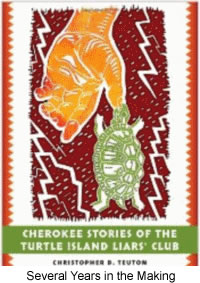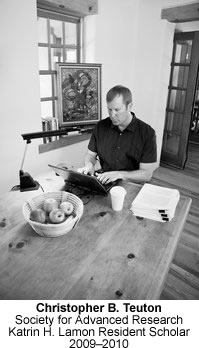 |
Canku Ota
|
 |
|
(Many Paths)
|
||
|
An Online Newsletter
Celebrating Native America
|
||
|
March
2013 - Volume 11 Number 3
|
||
|
|
||
|
American Indian Storytelling
Revealed with Truth and Lies
|
||
|
by Levi Rickert - Native
News Network, editor-in-chief in Entertainment
|
||
 A
Book Review A
Book ReviewCherokee Stories of the Turtle
Island Liars' Club There is a humorous scene in the 1998 "Smoke Signals" film, written by Sherman Alexie, when Suzy Song, played by Irene Bedard, asks Evan Adams' character, Thomas Builds-the-Fire, "Do you want lies or do you want the truth?," and he responds, "I want both." The line is both funny and real in that in life many times there is a fine line between truth and fiction. Old American Indian storytellers knew the concept well and the concept has been passed down through generations. "Cherokee Stories of the Turtle Island Liars' Club," published last month by the University of North Carolina Press, is written on this premise storytellers are indeed liars. With the Cherokee language there is no one word for storyteller. Instead the Cherokee use the word, "gagoga," pronounced: gah-goh-gá. Gagoga is literally translated as "he or she is lying." Several years in the making, "Cherokee Stories of the Turtle Island Liars' Club" introduces readers to a group of four Cherokee storytellers: Hastings Shade, Sammy Still, Sequoyah Guess and Woody Hansen. The four were the core of the original Turtle Island Liars' Club. The club has no formal set of by-laws, nor does it have an organizational structure. It is the name given to about a dozen Cherokee storytellers.
The interviews contained in the book are fascinating because they discuss the history and culture understood by the four storytellers: Hastings Shade, Sammy Still, Sequoyah Guess and Woody Hansen. Hasting Shade, who passed away in February 2010, was the senior elder of the Liars' Club. He had served as the deputy chief of the Cherokee Nation. In 1991, Chief Wilma Mankiller of the Cherokee Nation declared him a Cherokee National Treasure. Sammy Still is the editor of the "Keetoowah News" tribal newspaper of the United Keetoowah Band of Cherokee Indians, where he is a tribal citizen. "I've learned all this from my elders. I give all credit that I know - the stories, everything I've learned heard, everything I've said - I give credit to the elders," Still tells Teuton. Sequoyah Guess, also a tribal citizen of the Keetoowah Band of Cherokee Indians, is a novelist, filmmaker and Cherokee language teacher. Guess reveals his grandma who lived to be 98 decided she would pass her Cherokee stories on to him so that he would pass them on to future generations of Cherokee people. Woody Hansen has worked as a community health and wellness advocate for the Cherokee Nation. He is an unassuming man who is not interested in titles, but his stories are those of survival of having been near death several times in his life. All have been accomplished storytellers for years. The storytellers learned the Cherokee language and teachings. The formed what was known as the Turtle Island Liars' Club. It is easy to see why Chief Mankiller declared Hastings Shade a Cherokee National Treasure. His stories were filled with powerful meaning. "Cherokee Stories of the Turtle Island Liars' Club" is an amazing book that will delight Cherokees, other American Indians and others because it is a book that reveals so much about the art of Indian storytelling. Readers will sense the storytellers have a sense of responsibility to pass down the true meaning of life within the context of tribal culture - even if you wonder if there are some lies included in their stories.
School
for Advanced Research |
|
|
||
|
|
||
| Canku Ota is a free Newsletter celebrating Native America, its traditions and accomplishments . We do not provide subscriber or visitor names to anyone. Some articles presented in Canku Ota may contain copyright material. We have received appropriate permissions for republishing any articles. Material appearing here is distributed without profit or monetary gain to those who have expressed an interest. This is in accordance with Title 17 U.S.C. Section 107. | ||
|
Canku Ota is a copyright ©
2000 - 2013 of Vicki Williams Barry and Paul Barry.
|
||
 |
 |
|
|
The "Canku
Ota - A Newsletter Celebrating Native America" web site and
its design is the
|
||
|
Copyright ©
1999 - 2013 of Paul C. Barry.
|
||
|
All Rights Reserved.
|
||
 The
core group of four was interviewed by the book's author, Cherokee
scholar Christopher B. Teuton. The result of Teuton's effort is
a presentation of the interviews with actual Cherokee stories. So
many times, the public may hear the rich Indian stories told in
an auditorium, but goes away without knowing much about the actual
storytellers. The interviews in the book provide a rare glimpse
into the lives of Indian storytellers. In that regard, "Cherokee
Stories of the Turtle Island Liars' Club" is a treat.
The
core group of four was interviewed by the book's author, Cherokee
scholar Christopher B. Teuton. The result of Teuton's effort is
a presentation of the interviews with actual Cherokee stories. So
many times, the public may hear the rich Indian stories told in
an auditorium, but goes away without knowing much about the actual
storytellers. The interviews in the book provide a rare glimpse
into the lives of Indian storytellers. In that regard, "Cherokee
Stories of the Turtle Island Liars' Club" is a treat.